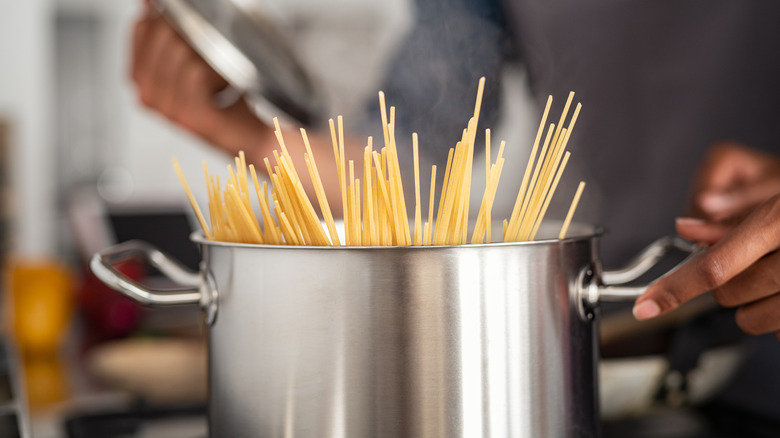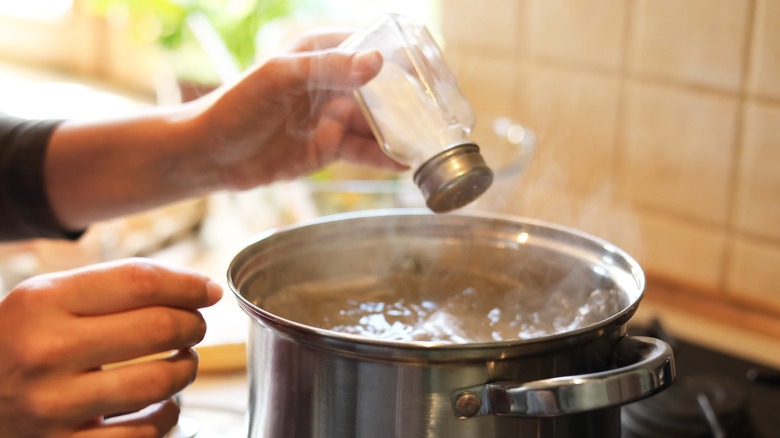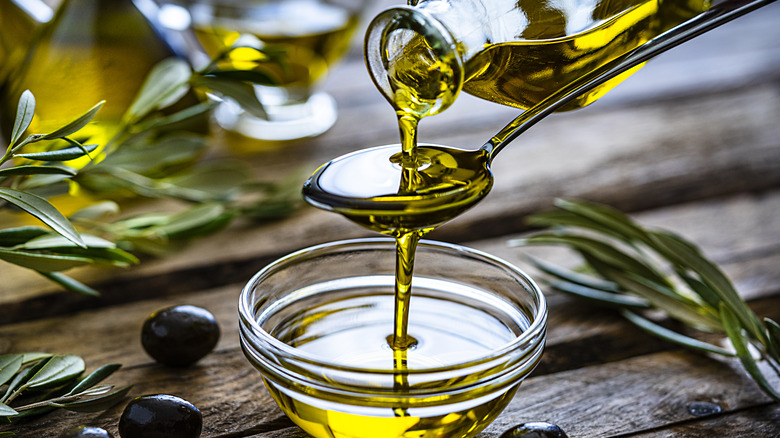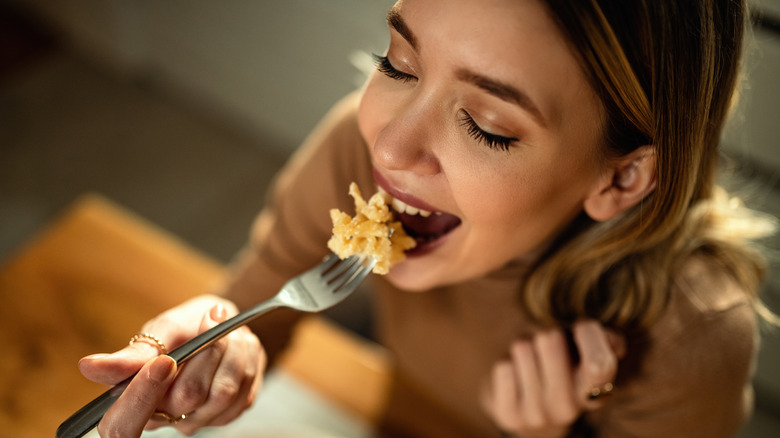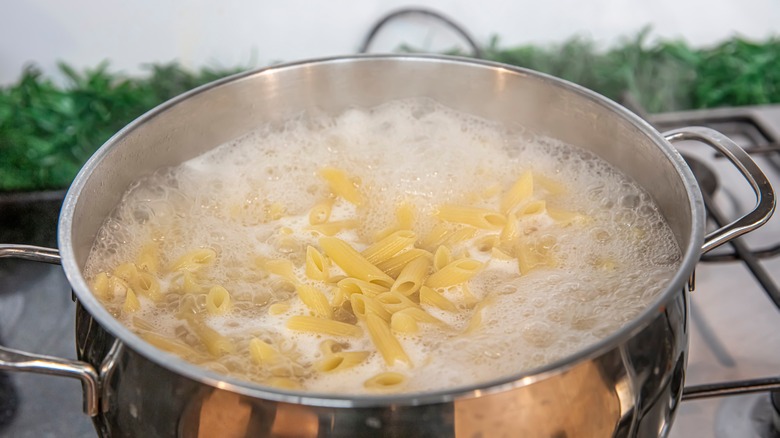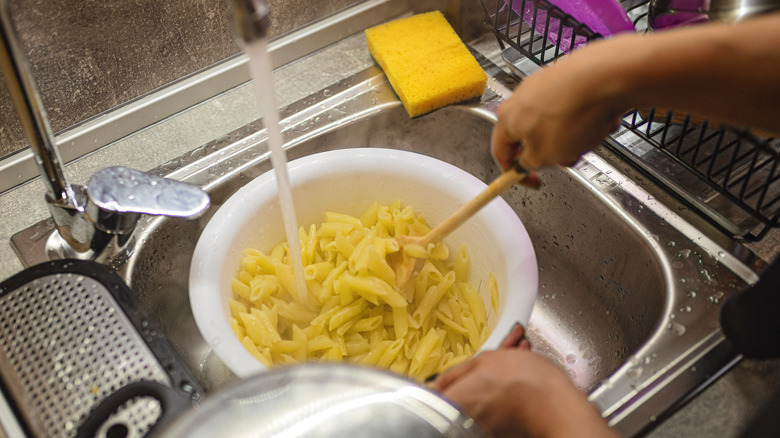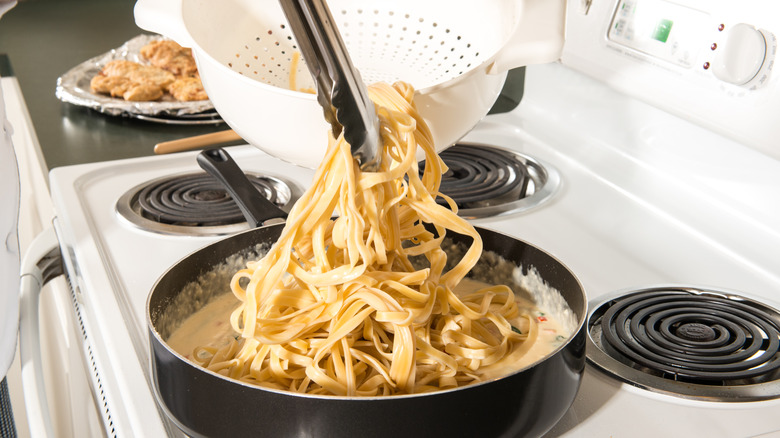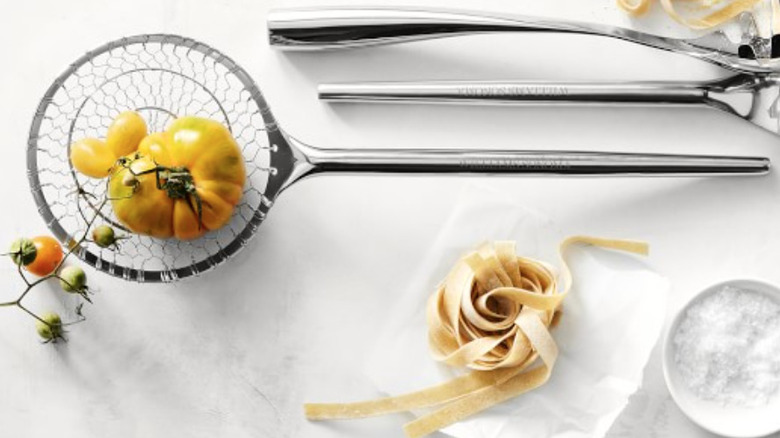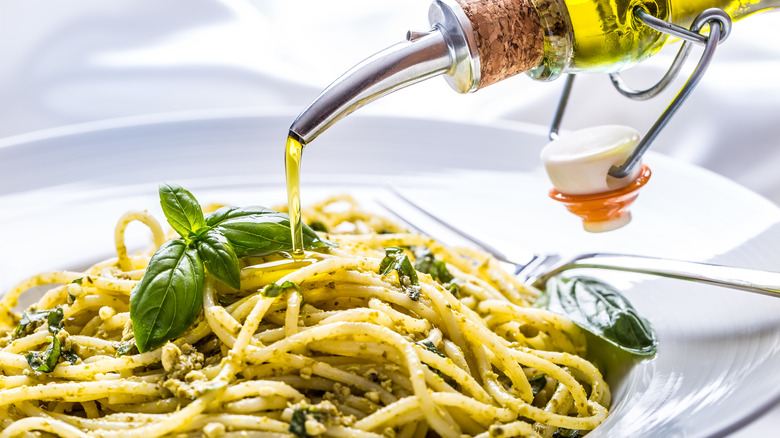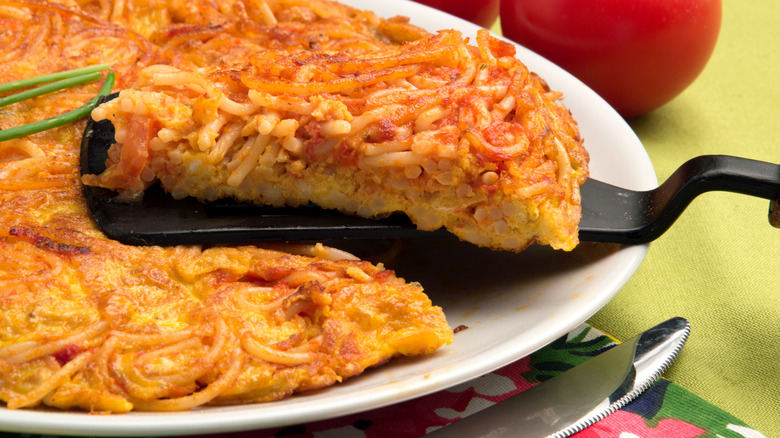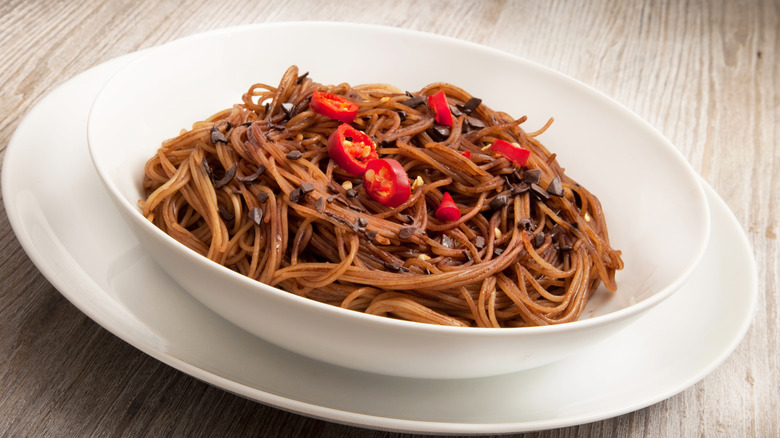Giada De Laurentiis' Go-To Tips For Cooking Perfect Pasta
We're not dinking around with some viral TikTok spaghetti trend. And we're not about putting out feelers in the comments section, just to get a bunch of microwave hacks for grade F ramen. (Oh, drown it in Velveeta? Yeah, that's a hard pass.) This time, we're aiming for the rafters, hitting up the most goddess-i-est godmother of pasta making we could freakin' think of: Giada De Laurentiis. And we're here to crush a pot 'o' pasta! [Cue: Heavenly chorus.]
Mushy macaroni? Cardboard campanelle? Trashy tortiglioni? We're done with all that schlutzkrapfen! Scrape those crusty noodles off the wall. With a few of De Laurentiis' hot tips tucked into your mind grapes, you'll be slingin' scialatielli like you own the place! And it's covered in a booty load of parmesan cheese, of course.
Get ready to roll that boil, go heavy on flavor, and stick that al dente landing for a perfect 10. This is pasta done right — like, really right. You'll be plating up pici pasta like a pro, faster than you can say "maccheroncini di Campofilone." (What's that now?) Andiamo!
Going long? Go tall
No more breaking uncooked spaghetti into a million jagged stubs and stuffing it into a tiny saucepan to allegedly cook. According to the goddess of Everyday Italian, the best way to introduce your long pasta to its new stove-top jacuzzi is to ... do nothing.
Long pastas, like spaghetti, fettuccine, linguine, and bucatini — ugh, so good with the little hole in the middle to hold all the sauce, like a mini gravy hose — need a lot of room to cook. Let them spread their starchy wings with a pot that's as tall as they are. This keeps the pasta from forming the equivalent of a rat king and clumping together as it cooks. But don't freak out if some of the pasta doesn't instantly submerge into the boiling water. Yes, with pasta, we're on the clock, but in a few moments, the rest of the noodles will gently sink into the bubbly bath.
Hold it, you, with your old-timey, Tuscan wooden spoon ... no pressing the pasta down into the water, either. With a little patience, things will be rolling along just as they should. As De Laurentiis shared on her YouTube channel, Giadzy, "Just give it a minute, it will start to soften as it hits the hot water ... Let it be, it starts to soften, and voila, it starts to cook."
Get salty
Flavorless pasta can take a seat next to unsalted nuts, iceberg lettuce, and zwieback biscuits. Since you probably (read: 100% definitely) want a little oomph with your noodles, allow us to suggest that you recreate the salty Mediterranean Sea in just a couple quarts of already-boiling water. Because Giada De Laurentiis says so.
If you feel a little skittish about possibly adding too much salt, you might be surprised at the amount of good old NaCl (chemistry!) a seasoned (dad joke!) chef might add. De Laurentiis goes for 1 tablespoon of salt for every 2 cups of water, explaining, "It is the first time you add flavor to the pasta. This is a very, very, very important step." Especially if you realize you forgot to buy actual spaghetti sauce, after you already put the pasta in the pot.
Make it the most fun way to spice up boiling water ever, with Disco di Sale (discs of salt). Packaged as compressed 10 gram tablets of fine Italian sea salt, just one disc'll do ya, for up to 6 cups of water. You can also find these party favors under the names "salt tablets" or "pasta salt," featuring authentic Sicilian sea salt, and hand-harvested Mediterranean sea salt. You can even use halite salt rocks for this, too. It's basic table salt, but it will feel like you're casually adding sparkly quartz crystals to your pasta water.
Skip the boiling EVOO
Someone definitely told you in college that you should add olive oil to pasta water so it doesn't foam up over the rim of the pot, as you cook the noodles. And we now know they were liars, and will be promptly kicked out of the lasagna lovers group chat on Facebook. Do not add any kind of oil to your cooking water. Save it for something else, like laying out and tanning by the pool like it's 1993.
Adding extra oil to the pot will actually come back to haunt you once you get to the sauce part of your dish, since it creates an impenetrable fortress around each noodle, preventing literally anything from sticking to it. It's like the penne noodle is a greasy pig, and you're the sauce, running around trying to catch that slippery bugger. Giada De Laurentiis advises, "You need all the natural starchiness from the pasta to come out. [Olive oil] stops that process."
The chef also claims this technique gained momentum, thanks to the tradition of home cooks boiling pasta in way-too-tiny pots. The oil sure helped to lube things up, but it was all wrong from the beginning. As De Laurentiis tells it, "The sauce never sticks to the pasta. It just slides right off." And we want that pasta sticking to everything, including our ribs.
Al dente or bust
Raise your hand if you've ever overcooked a pot of pasta. Throw a noodle at the wall every 30 seconds, and you still might not get it right. But even though we might feel like we're winging it when it comes to the perfect cook, we're all striving for that gold star texture: Al dente, or "to the tooth." Not too hard, not too chewy, juuust right.
Giada De Laurentiis explains to Williams Sonoma, "Al dente in Italian just means it has a little bit of a bite." And even if you're not a famous Italian celebrity chef, you can still make this happen relatively easily. As noted on the Giadzy blog, "What you're looking for in a perfectly al dente noodle is a good chew with a slightly undercooked layer in the center."
The best way to guarantee you're nailing it is to taste your noodles, as much as you have to. De Laurentiis' team notes that pasta cooking times range anywhere from four to 11 minutes, based on the thickness of each type of pasta. Angel hair? Start getting those noodles in your mouth on the earlier end. Artisanal pappardelle or cappelletti? Thick noods need more time in the pot before they're ready to sample. You can still throw spaghetti at the wall, but the reality is, just about any done-ness of pasta will stick! The only way to truly "al dente" is to mangia!
Pasta water is life
Save the oceans, drink pasta water! Well, almost. If you've been a loyal Giada De Laurentiis follower, you know she holds onto that precious pasta water like it's actual liquid gold. But even though we know this fact in our hearts, we still might be a little fuzzy on why she does it. (No, it's not because she sells it to super fans on eBay, although we suddenly see a gap in the market.)
Pasta water is the not-so-secret secret to creating the most glorious sauce you could ever accidentally drip on your shirt. As De Laurentiis notes, "It creates a wonderful, velvety, thick sauce without any cream, or anything else." But easier said than done, G. How much pasta water are we talking about here? A spritz? Several cups? The whole pot?
After a quick skim over some of her favorite recipes, it appears that De Laurentiis typically saves anywhere from 2 tablespoons to a full cup of pasta water, in order to finish a dish. But whatever the amount, it better be salted! She confirmed to PopSugar, "You should always add pasta water, for sure. And make sure it's pasta water seasoned very well with salt, because otherwise it doesn't taste like anything." We're feeling saltier by the second.
No rinse and repeat
A whole bunch of us elbow macaronis have spent our entire lives rinsing our pasta after we cook it. What the heck else are colanders for, other than rinsing grapes and pasta — no, not at the same time! Still, Giada De Laurentiis is putting the kibosh on this method once and for all.
"Don't ever, ever, ever rinse your pasta," she says, wagging her finger like she's been watching us rinse it this whole time. (Wait, is this a 2-way screen?) "You need all the starch in the pasta to create a uniform sort of dish where the sauce sticks to the pasta. You need every bit of that starch on that pasta."
Before you put Carol the Colander out to pasture, you can still keep her around to drain your pasta. (Come back, Carol!) And, not to contradict De Laurentiis, but there might be a time or two where your pasta would benefit from a gentle Spring shower. In the case that you don't want your pasta gluing itself onto other ingredients (hello, pasta salad), or becoming one with itself (like when you're cooking the pasta before you're ready to use it), it's cool if you rinse itto stop it from cooking, and to eliminate the extra starch. Promise we won't tell.
Sauce, pasta, cheese
Well, it's not quite that simple. It's also not that complicated. But before we throw everything at the steamy orecchiette willy-nilly, there's a method here that seems to work like a charm. So What Would De Laurentiis Do? Well, she's a sauce, pasta, cheese girl. We'll let her explain.
"I like to put my pasta into my sauce," she tells Williams Sonoma fans, adding, "That way the pasta finishes cooking in the simmered sauce." Okay, so we transfer the pasta to the pan with the sauce. Easy enough. It's completely opposite the glamor shots of pasta on spaghetti sauce jars, but we're in. Hold up though, before she tosses anything, she piles cheese on top of the naked pasta. "It's an old Neapolitan way of making pasta, and the way my grandfather taught me. You add the cheese to the pasta, and that way the sauce sticks to the cheese, that sticks to the pasta."
After you've added a suitable amount of cheese (we'll say when ... so, yeah, keep going ... not even joking right now), you do the lil pasta water magic trick, then toss to your heart's content. And eat to your belly's max.
All hail pasta spider
Screw Carol Colander (it's not you, Car, it's us) — we're all about the pasta spider. And not because De Laurentiis told us to use one. But also because De Laurentiis told us to use one.
What the heck is a pasta spider anyway? You've probably already seen one, but maybe called it something like "the strainy spoon," like we did. "Pasta getter thingie" rolls off the tongue nicely. It turns out it has a name, and a specialized job when it comes to pasta-based water rescues. It's SEAL Team Six for spaghetti and meatballs night.
Giadzy calls it an all-caps "GAME CHANGER," praising the easy-breezy transfer of pasta from cooking water to simmery sauce. No colander dumping needed. De Laurentiis' mom apparently once burned herself while pouring hot pasta into the sink, to drain. Practice safe pasta, people. Get a spider, and get to spidering.
EVOO and parm
Giada De Laurentiis is sauce, pasta, cheese. Jersey Shore is gym, tan, laundry. But sometimes you just need to glow up the same old routine with something new. Live a little! Enter extra virgin olive oil and parmesan cheese. And tan. Always tan.
As a final touch, De Laurentiis never misses a chance to top off her pasta with a little Italian finesse. Along with pasta water, she told PopSugar, "I always finish with EVOO [extra virgin olive oil], and I always finish with freshly grated parmesan. Those three things, I always do, without fail, no matter which pasta I make." Just for the record, we probably wouldn't say no to extra olive oil and cheese on many, many things.
The chef also offers more than 30 different olive oils in her online shop, so she seems pretty serious about us finding one we love. As far as parm goes, De Laurentiis prefers a generous Italian parmigiano-reggiano shave versus a store-bought grated parmesan situation. Parm-reg packs a lot more flavor, and since it boasts a higher price point, just a bit becomes the perfectly sharp and nutty cherry on top of your pasta sundae.
Leftover breakfast
Not gonna lie, after a long night of (okay, okay, literally any activity past 9 p.m.), leftover lasagna is where it's at. Cold pizza? Delicious. Lasagna? Basically pizza in the shape of a brick. Done. But while we may be chill about chowing straight from the fridge, we had no idea we could zhuzh up our leftover noodles to create a brand new meal. It's pasta for breakfast and why didn't we think of this already.
Pizza di spaghetti requires just three main things you could easily have in your house already; spaghetti from yesterday, a round skillet, and your favorite pajamas, preferably with an animated character from a far away holiday on them. Because why cook perfect pasta once, when you could perfectly cook it twice!
Giada's signature recipe has us tossing our leftover sketti with eggs, milk and parmesan, then cooking it in an oiled skillet, for eight minutes per side. At that point, it's a single serving straight from the pan, unless you feel like sharing by cutting it into wedges and presenting it on actual civilized plates. Is it weird to top it with a dollop of whipped ricotta, a few pepperonis, and a drizzle of honey? Hey. We're eating at home in our Garfield Christmas jammies. We do what we want.
Chocolate pasta
Bet you weren't even thinking about how to cook the most incredible chocolate pasta! ("The Hills Are Alive" from the "Sound of Music" suddenly plays everywhere, and we blissfully twirl atop a chocolate spaghetti mountain.) One of Giada De Laurentiis' favorite childhood treats was, indeed, spaghetti with sweet, melty chocolate. (Sigh. Is this what it feels like to fall in love?)
Just so we're all on the same page, this is regular pasta, with chocolate mixed into it — not chocolate-flavored noodles. And trust us, De Laurentiis had us at "choc—."
She hasn't given up the exact recipe of her youth, but we did a little digging of our own, like truffle pigs if the truffles were the chocolate kind. One version we found involved melting chocolate chips in a pan, along with butter, cream, and sugar, then tossing in the cooked spaghetti, and topping everything with powdered sugar. Another added a delightful dollop of whipped cream, with strawberries. Could you scoop a heaping spoonful of Nutella into a bowl of freshly cooked spaghetti, and call it a day? Well, dear chocolate spaghetti bestie, we don't see why not!


